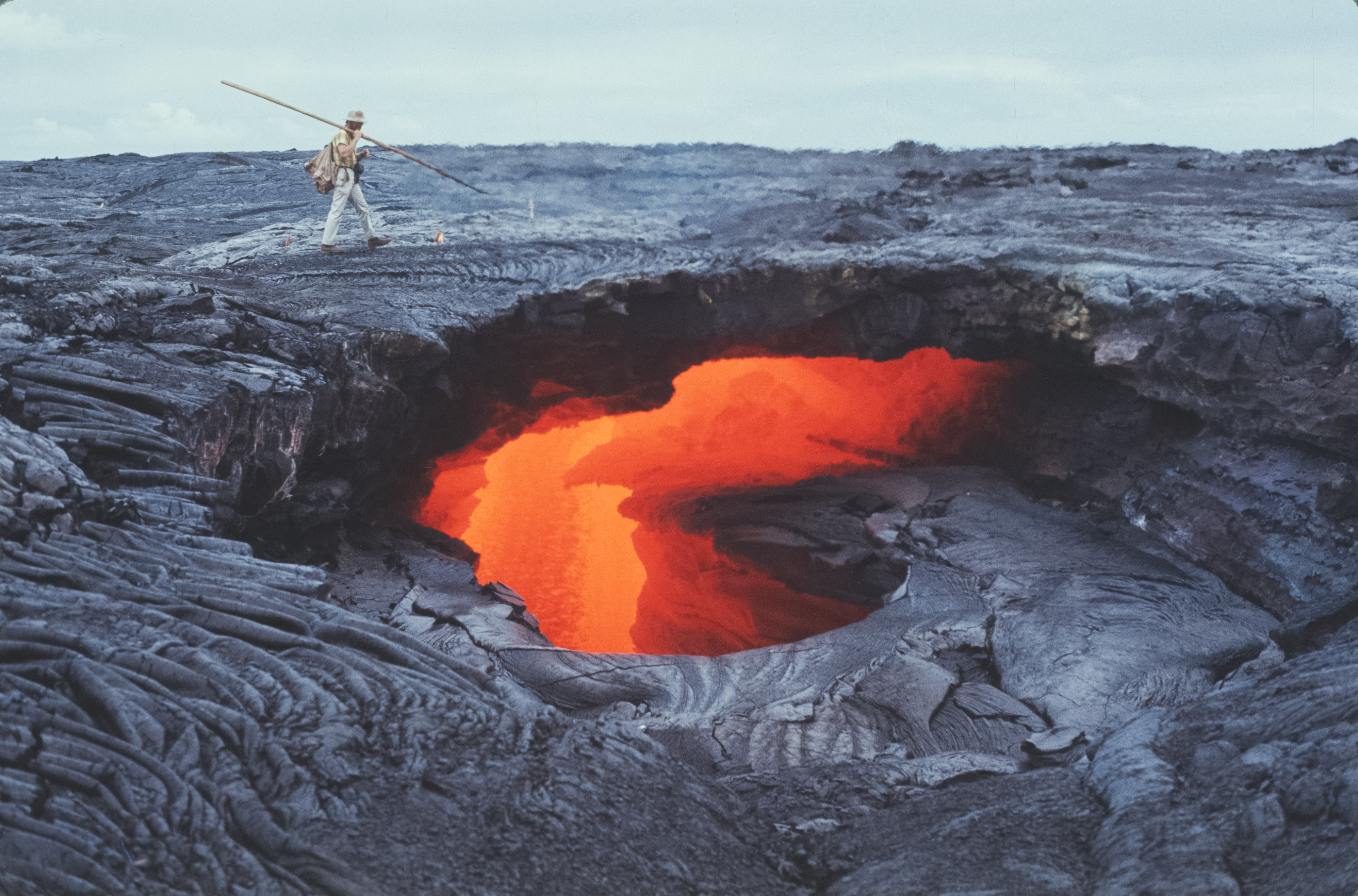
Credit: J. Judd/USGS
For thousands of years, humans have found shelter in lava tubes. In the future, they may do the same—on the Moon!
A lava tube is a cave. It forms when lava flowing in a channel forms a crust on the upper surface that’s exposed to cooler air.
The crust insulates the lava below, which gets superheated and melts a deeper tube-shaped channel as lava continues to flow through it. When the lava runs out, it leaves a tunnel.
In places with lots of volcanic activity, there are networks of lava tubes, some of them miles long.
Openings to the surface, called skylights, let in rain and sun and have made lava tubes habitable cave environments for wandering humans for millennia.
Scientists have evidence that the Moon and Mars also have lava tubes, which could be perfect locations for potential future human colonies, sheltered from cosmic rays and meteorites.
In those lower gravity settings, lava tubes should be much wider and taller than on Earth. So large in fact, that they could hold an entire colony. Lava tube networks could also provide routes for roads and perhaps lead to reservoirs of water ice.
For these reasons, future missions to the Moon and Mars will use ground-penetrating radar to search for lava tubes. And if humans one day colonize space, they may start in shelters like those that protected their ancient ancestors on Earth.
Background
Synopsis: As much as 10,000 years ago, ancient shepherds and their flocks made their way across a great unknown—moving from oasis to oasis across the desolate volcanic fields of the Arabian desert. Along the way, they stopped in a cave-like lave tube for shelter and water. Earth’s lava tubes can be as much as 40 mi long, and they may be even larger on planets with lower gravity. Today, as humans contemplate reaching out to the Moon, Mars and beyond, lava tubes could play an important role.
- Archaeologists recently made a remarkable discovery in remote volcanic fields in the Saudi Arabian desert—evidence of human habitation within and around a large lava tube dating back as much as 10,000 years.
- In addition to huge expanses of sand and gravel, the western desert of Saudi Arabia includes large lava fields known as harrat.
- While some of these volcanic fields parallel the Red Sea, other harrats align along a north–south trend thought to extend from the Afar Mantle Plume.
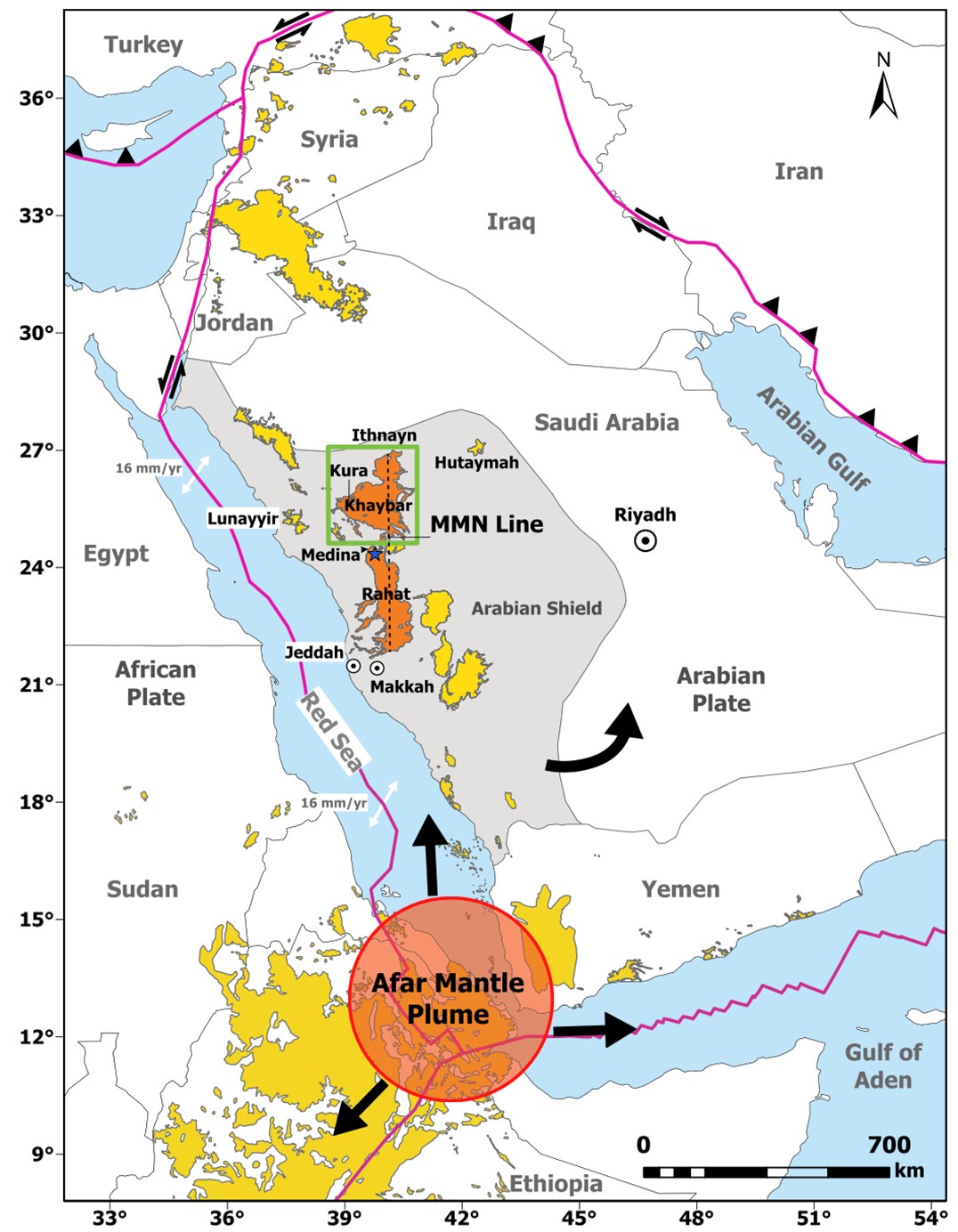
Location map of Arabian harrats in western Arabia. The gray region shows the Precambrian Arabian shield in Saudi Arabia while yellow areas represent the Cenozoic volcanic fields. Volcanic fields that trend along a north–south line are highlighted in orange. Harrat Khaybar is in the green box.
Credit: Alohali et al. (2022), CC BY 4.0, via BMC - The complex volcanics of Harrat Khaybar began to form about 12 million years ago, covering around 5,400 mi2 (14,000 km2) of the Precambrian Arabian Shield, with the most recent volcanism occurring just 700–600 years ago.
- In 2019 an archaeological team began exploration of a large lava tube in one of the dark colored basaltic areas of Harrat Khaybar and found numerous pictographs, stone tools dating to 10,000 years ago and human bone fragments dating to 7,000 years ago.
- Umm Jirsan (Arabic for “Old Mother”) cave is about 150 ft (45 m) wide with ceilings up to 40 ft (12 m) high.
- It extends 5,000 ft (1,500 m) as it drops from the east toward the west, capturing water that enters its skylights during occasional torrential rains and funneling it downward into sediments that support plants and trees.
- It feels cool in the summer and warm in the winter, making it an ideal temporary refuge for humans and their livestock between oases.
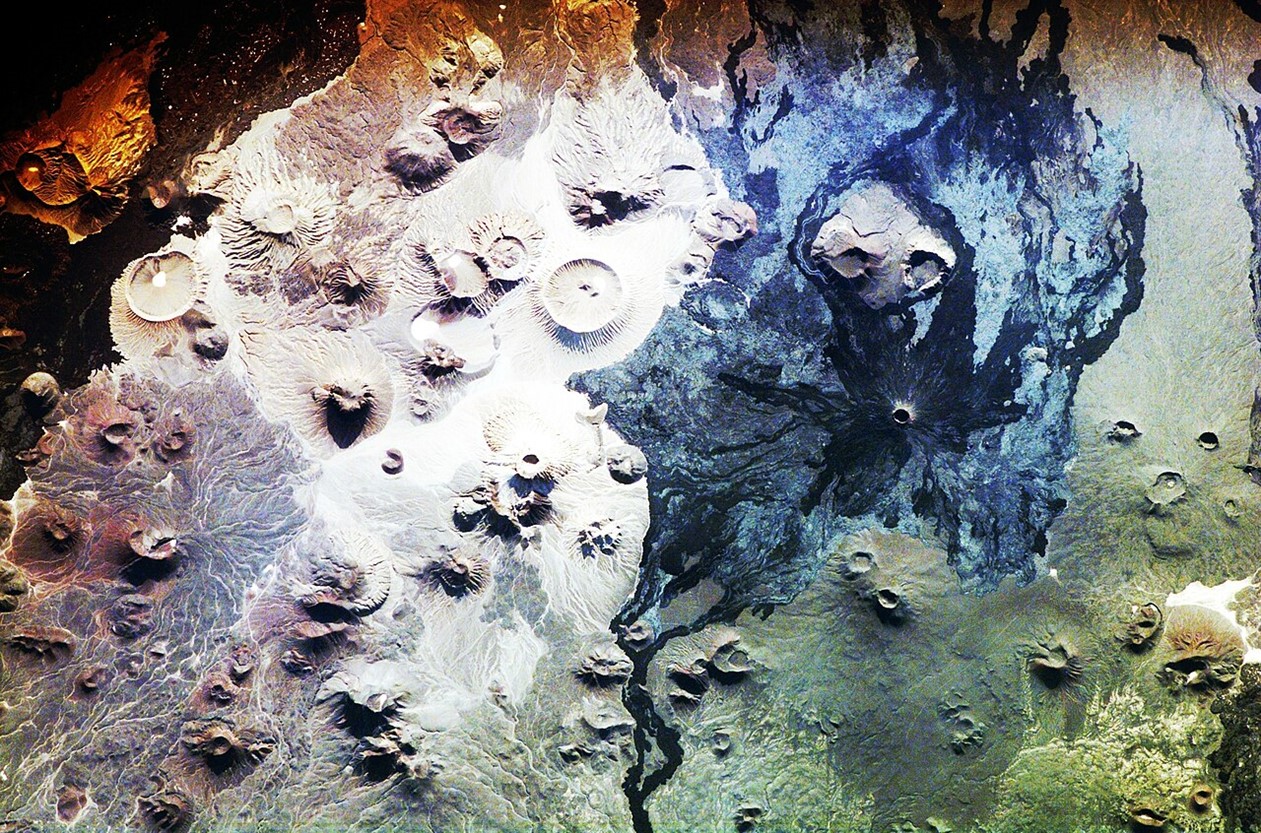
Harrat Khaybar is a 5,400 square mile (14,000 square kilometer) volcanic field in central Saudi Arabia located about 85 miles (137 kilometers) northeast of the city of Medina (Al Madinah). The Umm Jirsan lava tube is located in the blue-black colored basalts in this International Space Station astronaut photo.
Credit: Expedition 16 Crew Member on the International Space Station, NASA, public domain, via Wikimedia Commons
- Lava tubes are caves that form within basaltic flows during quiescent volcanic eruptions.
- Lava tubes form when the top layer of a lava flow cools to form a crust over hot lava that continues to flow beneath it.
- Superheated by the insulation of the of the crust, the flow melts underlying rock to form a cylindrical tube.
- When the magma chamber empties, the tail of the lava flow continues downhill, leaving the partially empty lava tube behind.
- The bottom of the tube fills with collapsed material to make a flatter floor.

The evolution of a lava tube.
Credit: NPS - Lava tubes are found in regions characterized by extensive volcanism, such as Iceland and Hawai‘i.
- A lava tube formed on La Palma in the Canary Islands in late 2021, and it was still superheated inside more than two years later.
- The longest known lava tube on Earth is Hawai‘i’s Kazumura Cave, a complex that stretches over 40 mi (65 km) from the edge of Kīlauea’s caldera eastward toward the town of Puna.
- It formed during an eruption of Kīlauea’s that occurred more than 500 years ago with passages that are as much as 69 ft (21 m) wide and 59 ft (18 m) high.

With a surveyed length of more than 40 miles (65 kilometers), Hawai‘i’s Kazumura Lava Tube is the longest lava tube complex yet discovered on Earth. On the eastern flank of the Kīlauea Volcano, hot lava formed interconnected arched passages around five centuries ago. In this image, the floor of the lava tube, formed as a crust on a lava lake, collapsed downward after an ancient lava lake emptied. The tube drops more than 3,600 feet (1,100 meters) along its course from near the caldera toward the town of Puna.
Credit: Dave Bunnell / Under Earth Images, CC BY-SA 4.0, via Wikimedia Commons - More recent lava tubes extend all the way from Kīlauea’s caldera to the sea, where they add land to Hawai‘i’s big island.
- It formed during an eruption of Kīlauea’s that occurred more than 500 years ago with passages that are as much as 69 ft (21 m) wide and 59 ft (18 m) high.
- Well before Neil Armstrong first set foot on the Moon on July 21, 1969, humans imagined traveling through space and living on other planets, where future human colonists would have to worry about things like cosmic radiation, micrometeorite showers, huge temperature fluctuations or superdry surface environments.
- If present, lava tubes formed by basaltic magma flows on other planets could provide humans with essential protection from these harsh conditions.
- With its gravity just 38% of Earth’s, lava tubes on Mars could reach widths more than ten times those on Earth—as much as 820 ft (250 m) across.
- Their subterranean ceilings could be taller than the Empire State Building (1,250 ft [381 m]), potentially providing space for Mars bases.
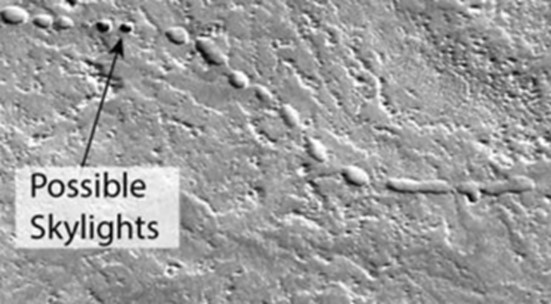
An image from the Mars Reconnaissance Orbiter shows a possible lava tube on Mars near the southern flank of the Martian volcano Arsia Mons.
Credit: Mars Reconnaissance Orbiter/NASA - The lower gravity on Mars would also make them less likely to collapse.
- Their subterranean ceilings could be taller than the Empire State Building (1,250 ft [381 m]), potentially providing space for Mars bases.
- Lava tubes on the Moon are as much as four times as wide as those on Mars, reaching an astonishing 3280 ft (1 km) across.
- NASA’s Gravity Recovery and Interior Laboratory (GRAIL) mission detected "enormous subsurface voids" beneath the lunar surface that may be huge lava tubes.
- Entire cities could fit inside one with buildings as tall as Dubai’s Burj Khalifa (2,722 ft, [829 m] currently Earth’s tallest manmade structure).
- Numerous “pits” located along tracks visible all over the lunar surface may be skylights that could provide access to these underground refuges. Some are as large as football fields.
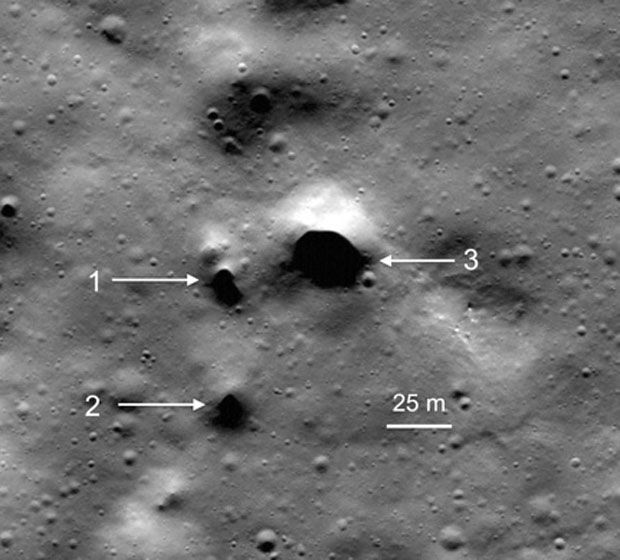
NASA Lunar Reconnaissance Orbiter images spot the newly discovered lava tube skylight candidates at Philolaus Crater near the Moon's north pole.
Credit: NASA/Lunar Reconnaissance Orbiter/SETI Institute/Mars Institute/Pascal Lee
- Besides protecting colonists, lava tubes may provide routes for underground roads and also host hidden water ice accumulations that could be harvested.
- Scientists are developing detailed plans for exploring tubes on the Moon and Mars on future missions starting with using ground-penetrating radar to map their extent before accessing them using rovers or helicopters.
- Lava tubes have hosted humans for millennia in the past and will probably host them for millennia in the future.

